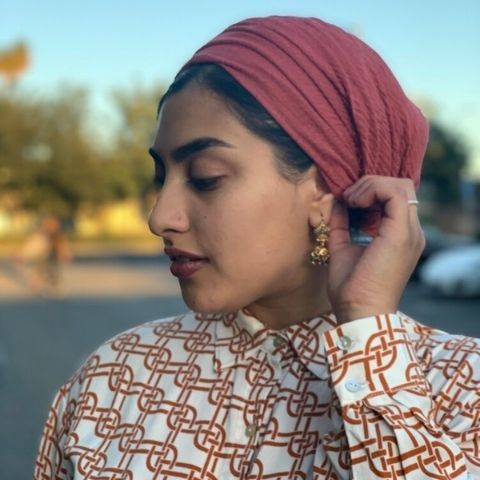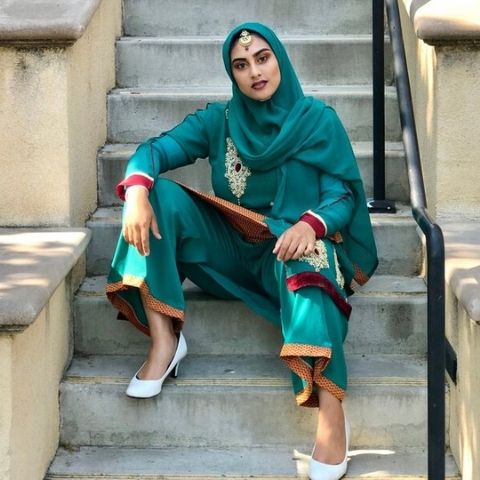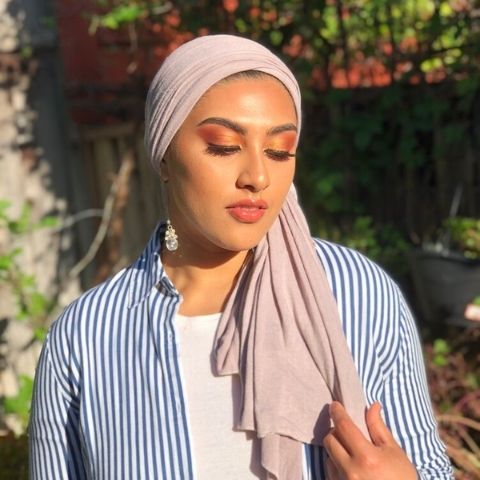How advocate Haleema Bharoocha is building a safer world for Gen Z women
April 8, 2020
Haleema Bharoocha on gender, justice, and activism.
By Samia Abbasi, Editor
Haleema Bharoocha is a Muslim-Indian-American gender justice activist based in the San Francisco Bay Area, California. She is the Advocacy Manager at Alliance for Girls and a core volunteer of South Asians 4 Black Lives. She leads media trainings for Muslim women and empowers her community through her work with Malikah. When she’s not community organizing, she is an avid weight-lifter and photographer.
With her powerful brows, impeccable hijab styles, and a wardrobe that deserves a blog post of its own, Haleema is a Gen. Z gender justice advocate I’ve admired for many years. I know her as someone who embodies the notion that “action speaks louder than words.” I caught up with Haleema to talk about her personal experiences that led her to gender equity work and how she looks effortlessly gorgeous in all her pictures.

photo credit: Haleema Bharoocha
Early memories: understanding identity
“When I was growing up, I was home-schooled from kindergarten up until middle school, and Urdu was my first language. That really shaped the way I grew up and how I saw the world. All my media was pretty monitored by my parents who wanted me to stay rooted in my cultural and religious identity as a South Asian-Muslim. They’re very anti-assimilationist, so because of that, I didn’t have a lot of language for the different things happening in my community. People would say things to my mom like, ‘Go back to your country!’ or ‘You’re a terrorist!’ And I didn’t understand where that was coming from. I’d only wear Desi clothes outside when I was young. All my friends would wear American clothes and I would wear a salwar kameez.
When I’d ride my bike, I’d tie up my salwar kameez, so it wouldn’t get stuck in the wheels.
I was cool with that up until middle school (when I stopped being home-schooled), and my classmates would make comments like, ‘What are you wearing?!’ At that point, I developed a lot of shame around my cultural identity and really wanted to assimilate, so I fought with my parents about wanting to wear American clothes.
So, I grew up in this really interesting anti-assimilation environment where I wasn’t really politically aware of what was going on, but I saw the impacts of it on people around me. A lot of my Muslim counterparts in other schools had a very different experience—either with being bullied or having their hijabs taken off by their parents to protect them. And I had a different experience, because I didn’t know that was happening or what it meant.
It was only in the ninth grade (2012), that I understood 9/11 for the first time. I had seen images and I had heard of it, but did not have a clear understanding of how it resulted in this rise in Islamophobia in America. I was really curious about the history of these events. It took me having to pick a topic and do a lot of research on it to fully understand what was going on.
That led me to study Sociology at Seattle University, which is really the study of people, culture, society, and power structures. It was powerful to understand and be able to pinpoint, ‘This was Islamophobia,’ or ‘This was gender-based violence.’ Going to university really impacted how I saw the world. I became independent in my thought and more comfortable with questioning systems and rules. It helped me be an advocate—to be in a space where I’m okay with bending the rules or advocating for something other than what’s been set for people.
Career: from personal experience to community action
Growing up, my grandfather would say things like, ‘You need to practice how to cook and clean for when you get married.’ or ‘Oh, you’re not that smart, because you’re home-schooled.’
I personally believed that being a girl wasn’t good enough.
When I started going through puberty, that made it worse. I would hear disgusting comments from guys, was called names like ‘hoe-jabi,’ and men would follow me while walking home from school.
It took me a while to understand that this wasn't about me, what I was wearing, or the size of my boobs. Educating myself and being in spaces with other advocates made me understand that this was power, control, and how the patriarchy manifests. I began to really unlearn that toxic mentality and to re-learn what gender equity and justice mean, and how we can really shift the conversations in South Asian and American culture. I think there’s a convergence of 2 different kinds of cultural patriarchy and sexism that you have to navigate as a South Asian woman. There’s also a layer of gendered Islamophobia to it, and you’re navigating 3 different forms of patriarchy that manifest in their own ways. You kind of have to identify, ‘How do I deal with this on a personal level? How do I have conversations about this with my community if they’re not willing or ready to look at it?’ That helped spark my work in gender justice.
Right now, I am the Advocacy Manager at Alliance for Girls, the nation’s largest girl-serving organization. Through the Girls Policy Agenda, we’re addressed gender-based violence and sexual harassment on public transportation by working with transit agencies to add a gender-equity lens to new and existing safety measures.
Something I’m really proud of is being Gen. Z, a young person in this work. It’s a huge advantage, because it allows me to understand the experiences of the girls that I’m serving.
My mantra is ‘By us, for us.’ So, systems need to be created by our community, for our community. When it comes to women and gender-expansive people, we need to be at the center of decision-making. I want to be able to advocate for my peers, as a peer myself.

photo credit: Haleema Bharoocha
Beauty philosophy: on turbans & traditional looks
When I first started wearing hijab I had a lot of mixed feelings, like, ‘How do I look pretty or fashionable? How do I match it with my outfit? Or wear it to the gym?’ I was super self-conscious about that. And, of course, I also struggled with body image. I went through a year where every day, I ate raw vegetables and bowls of lemons and ran multiple miles. I think that was eighth grade. The year after that, it was the opposite where I was binge-eating food all the time. I felt the struggle of needing my body to look a certain way and not feeling happy with it. Now, I’m coming to a place where I’m happier with how I think about my body and the way I approach beauty.
I started to work out not for my weight or to look a certain way, but more so for being healthy.
I really love wearing various forms of turbans as my hijab style. That’s my go-to look, but it took me a while for that to be something I was allowed to do. I had to have conversations with my parents about me showing my neck or what’s acceptable and appropriate. There are certain places, of course, that I go to where I’m super conscious of that, like the mosque. So, instead of wearing a turban, I’ll wear my hijab down.
I think a lot of beauty we see in the media right now is geared toward Euro-centric, light-skinned beauty looks. Even if you look at who’s being represented in Bollywood, there are a lot of light-skinned South Asians. Our diaspora is so diverse, so I’d love to see more representation of darker-skinned South Asians, different cultures within the diaspora, and more traditional South Asian beauty shown in the media.

photo credit: Haleema Bharoocha
Style & makeup: Desi color palette
I think I’m gearing more toward comfort right now. I’ll wear Adidas with my suits and dresses.
My color palette is a mix of warm and cool tones. I’d say that I gravitate toward a lot of beach colors: blues, beiges, and colors like that. But there are times where I like wearing more muted maroons and pale pink-toned looks. Those are my two favorites. I like a lot of warm eyeshadows: some golds, oranges, and more subtle browns and beiges. It’s a very traditional Desi color palette. Usually for lips, I love lighter pinks, like this one from Bobbi Brown. I’ll sometimes do darker lip products, but only if that’s the only thing I’m doing to my face.
I used to wear makeup every day, but now I only wear makeup, maybe, once a month. When I do wear makeup, I use Fenty foundation and set it with powder. I love the Fenty foundation because it’s very smooth. My main thing that I love to do for photoshoots and speaking engagements is brows, highlighter, and lips. But if I’m going out, I’ll wear eyeshadow and put on some Benefit They're Real Mascara. For my eyebrows, I use black eyeshadow, a brow pencil, and a brow brush to sculpt them. I’m a huge fan of highlighter—I use the Benefit Watts up! Highlighter. I love that it’s cream-based and comes in a stick! You just dab it on your cheekbones with a brush or your fingers and smooth it out. My signature scent is the Yves Saint Laurent Black Opium perfume."




